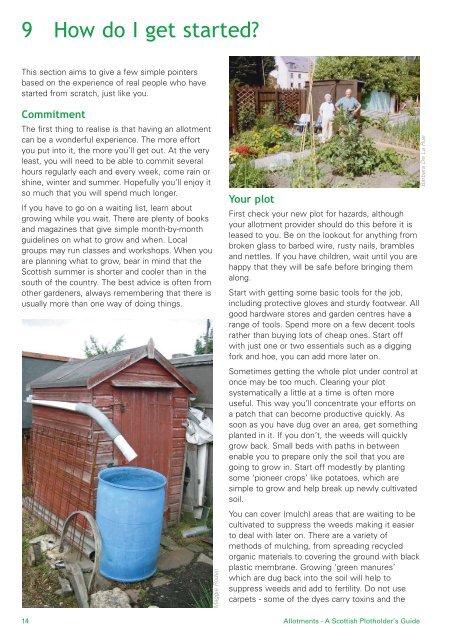Scot plot guide Q3:layout 7 - Scottish Allotments and Gardens Society
Scot plot guide Q3:layout 7 - Scottish Allotments and Gardens Society
Scot plot guide Q3:layout 7 - Scottish Allotments and Gardens Society
Create successful ePaper yourself
Turn your PDF publications into a flip-book with our unique Google optimized e-Paper software.
9 How do I get started?This section aims to give a few simple pointersbased on the experience of real people who havestarted from scratch, just like you.CommitmentThe first thing to realise is that having an allotmentcan be a wonderful experience. The more effortyou put into it, the more you’ll get out. At the veryleast, you will need to be able to commit severalhours regularly each <strong>and</strong> every week, come rain orshine, winter <strong>and</strong> summer. Hopefully you’ll enjoy itso much that you will spend much longer.If you have to go on a waiting list, learn aboutgrowing while you wait. There are plenty of books<strong>and</strong> magazines that give simple month-by-month<strong>guide</strong>lines on what to grow <strong>and</strong> when. Localgroups may run classes <strong>and</strong> workshops. When youare planning what to grow, bear in mind that the<strong>Scot</strong>tish summer is shorter <strong>and</strong> cooler than in thesouth of the country. The best advice is often fromother gardeners, always remembering that there isusually more than one way of doing things.Maggie RodenYour <strong>plot</strong>First check your new <strong>plot</strong> for hazards, althoughyour allotment provider should do this before it isleased to you. Be on the lookout for anything frombroken glass to barbed wire, rusty nails, brambles<strong>and</strong> nettles. If you have children, wait until you arehappy that they will be safe before bringing themalong.Start with getting some basic tools for the job,including protective gloves <strong>and</strong> sturdy footwear. Allgood hardware stores <strong>and</strong> garden centres have arange of tools. Spend more on a few decent toolsrather than buying lots of cheap ones. Start offwith just one or two essentials such as a diggingfork <strong>and</strong> hoe, you can add more later on.Sometimes getting the whole <strong>plot</strong> under control atonce may be too much. Clearing your <strong>plot</strong>systematically a little at a time is often moreuseful. This way you’ll concentrate your efforts ona patch that can become productive quickly. Assoon as you have dug over an area, get somethingplanted in it. If you don’t, the weeds will quicklygrow back. Small beds with paths in betweenenable you to prepare only the soil that you aregoing to grow in. Start off modestly by plantingsome ‘pioneer crops’ like potatoes, which aresimple to grow <strong>and</strong> help break up newly cultivatedsoil.You can cover (mulch) areas that are waiting to becultivated to suppress the weeds making it easierto deal with later on. There are a variety ofmethods of mulching, from spreading recycledorganic materials to covering the ground with blackplastic membrane. Growing ‘green manures’which are dug back into the soil will help tosuppress weeds <strong>and</strong> add to fertility. Do not usecarpets - some of the dyes carry toxins <strong>and</strong> theBarbara De La Rue14 <strong>Allotments</strong> - A <strong>Scot</strong>tish Plotholder’s Guide













